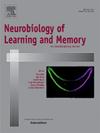Glutamate receptor expression in the PL-BLA circuit is associated with susceptibility to showing the PTSD-like phenotype
IF 1.8
4区 心理学
Q3 BEHAVIORAL SCIENCES
引用次数: 0
Abstract
While many individuals experience traumatic events during their lifetimes, only some go on to develop post-traumatic stress disorder (PTSD). This susceptibility and resilience to developing PTSD can be modelled in rodents using the stress-enhanced fear learning (SEFL) procedure, in which rats are exposed to a session of massed, unpredictable footshocks and subsequently assessed on tasks of adaptive fear learning. It has previously been observed that subpopulations of rats are susceptible and resilient to showing the PTSD-like phenotype following SEFL, and that these rats show differences in glutamate receptor expression in the basolateral amygdala. However, it is currently unknown whether structural differences are observed in other brain regions implicated in stress responding and memory. Using the refined SEFL procedure, this study aimed to determine whether expression of GluN2B, GluA1 and GluA2 receptor subunits in the prelimbic and infralimbic cortices, and dorsal hippocampus could be correlated to the SEFL-phenotype or shock experience in male rats. Here we show that following SEFL, differences can be observed in receptor subunit expression in the infralimbic cortex and dorsal hippocampus as a function of shock experience, whilst differences in the prelimbic cortex are associated with susceptibility. Importantly, these structural changes can be observed in male rats that are group-housed and exposed to 13-shocks rather than 15-shocks, indicating that the refined SEFL procedure offers a robust animal analogue of the non-associative fear sensitisation that occurs in PTSD. Future studies using this procedure could pave the way to the eventual development of pharmacological treatments to alleviate or prevent stress-induced psychopathology in susceptible individuals.
PL-BLA回路中的谷氨酸受体表达与ptsd样表型的易感性相关
虽然许多人在一生中经历过创伤性事件,但只有一些人会发展成创伤后应激障碍(PTSD)。这种对创伤后应激障碍的易感性和恢复能力可以通过压力增强恐惧学习(SEFL)程序在啮齿动物中进行模拟,在该程序中,大鼠暴露在大量的、不可预测的足震中,随后评估适应性恐惧学习的任务。先前已经观察到,大鼠亚群在SEFL后易受ptsd样表型的影响,并且这些大鼠在杏仁核基底外侧的谷氨酸受体表达上存在差异。然而,目前尚不清楚在与压力反应和记忆有关的其他大脑区域是否观察到结构差异。本研究利用改进的SEFL程序,旨在确定GluN2B、GluA1和GluA2受体亚基在雄性大鼠的边缘前皮层和边缘下皮层以及海马背侧的表达是否与SEFL表型或休克经历相关。本研究表明,在SEFL后,可以观察到边缘下皮层和海马背侧受体亚基表达的差异,这是休克经历的一个功能,而边缘前皮层的差异与易感性有关。重要的是,这些结构变化可以在集体饲养的雄性大鼠中观察到,并且暴露于13次电击而不是15次电击,这表明改进的SEFL程序提供了一个强有力的动物模拟,发生在创伤后应激障碍中的非联想恐惧敏感化。使用这种方法的未来研究可能为最终开发药物治疗铺平道路,以减轻或预防易感个体的压力诱发的精神病理学。
本文章由计算机程序翻译,如有差异,请以英文原文为准。
求助全文
约1分钟内获得全文
求助全文
来源期刊
CiteScore
5.10
自引率
7.40%
发文量
77
审稿时长
12.6 weeks
期刊介绍:
Neurobiology of Learning and Memory publishes articles examining the neurobiological mechanisms underlying learning and memory at all levels of analysis ranging from molecular biology to synaptic and neural plasticity and behavior. We are especially interested in manuscripts that examine the neural circuits and molecular mechanisms underlying learning, memory and plasticity in both experimental animals and human subjects.

 求助内容:
求助内容: 应助结果提醒方式:
应助结果提醒方式:


